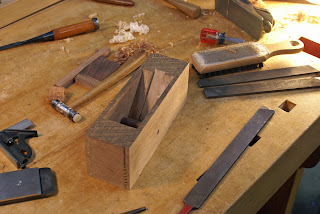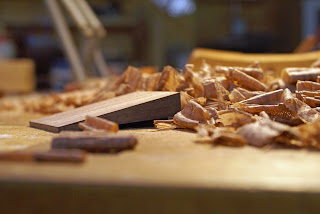Unfortunately I did not take a lot of pictures of this process sorry. During this process the alignment pins were invaluable; instead of worrying about lining all the pieces up all I had to do was focus on getting the cauls and clamps on.
After the dry run it was glue time. Another great tip from David was how to make a simple glue spreader with a piece of scrap wood and a few saw kerfs; I will definitely be making something like this for myself.
With the plane in the clamps it was on to shaping the plane hammer to go with the plane. For those of you who do not know small hammers (plane hammers) are used to adjust wooden planes. I roughed out the shape on the bandsaw and then over to the bench and refined the shape with rasps, files and spokeshaves.
Pinched in the tail vise and using a spokeshave
to shape the hammer handle
And with that my first day was done.
Day two started nice and early as well more tea and beautiful weather made the shop even more spectacular.
First thing was to take the plane out of the clamps and see what I had. At this point the plane was more or less a big block of wood but it did look good. The next step was to set up plane for sole flattening. To do this I had to make a temporary wedge so to tension the plane as it is flattened: first on a jointer then on sandpaper.
The plane blank just out of the clamps
With the sole flat the next thing was to make the final wedge with the plane iron. The fit of the plane iron and wedge is critical to the function of the plane. The wedge cannot be to tight or to loose and the fit must be consistent between the iron and the cross pin.
Using a block plane to fit the wedge
The finished wedge
With the wedge done it was time to try taking a shaving.
The very first shaving
The second shaving
After the initial test it was time to shape the plane. This part was fun: rasps, files, and spokeshaves.
After the shaping it was lunch time again, and after lunch it was time to play with the new plane. And with that my plane building experience was finished. The day finished off with some conversation between David and I.
A great experience and a wonderful learning experience. My deepest thanks to David Finck.
Cheers
Hans Christopher























